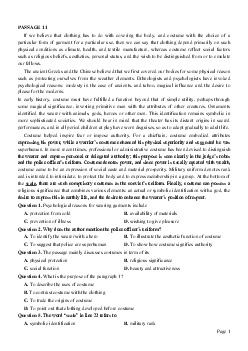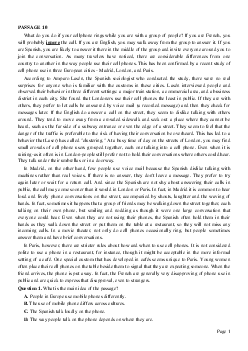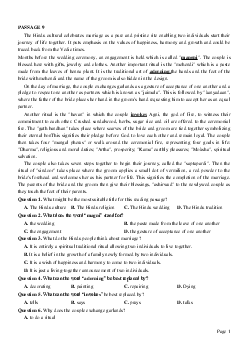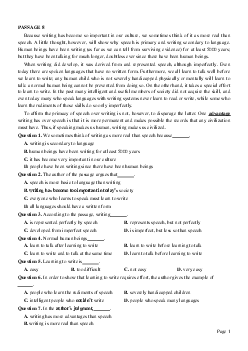


Preview text:
PASSAGE 25
The food we eat seems to have profound effects on our health. Although science has made enormous
steps in making food more fit to eat, it has, at the same time, made many foods unfit to eat. Some research
has shown that perhaps eighty percent of all human illnesses are related to diet and forty percent of cancer
is related to the diet as well, especially cancer of the colon. People of different cultures are more prone to
contract certain illnesses because of the characteristic foods they consume.
That food is related to illness is not a new discovery. In 1945, government researchers realized that
nitrates and nitrites (commonly used to preserve color in meats) as well as other food additives caused
cancer. Yet, these carcinogenic additives remain in our food, and it becomes more difficult all the time to
know which ingredients on the packaging labels of processed food are helpful or harmful.
The additives that we eat are not all so direct. Farmers often give penicillin to cattle and poultry, and
because of this, penicillin has been found in the milk of treated cows. Sometimes similar drugs are
administered to animals not for medicinal purposes, but for financial reasons. The farmers are simply
trying to fatten the animals in order to obtain a higher price on the market. Although the Food and Drug
Administration (FDA) has tried repeatedly to control these procedures, the practices continue.
A healthy diet is directly related to good health. Often we are unaware of detrimental substances we
ingest. Sometimes well-meaning farmers or others who do not realize the consequences add these
substances to food without our knowledge.
Question 1. How has science done a disservice to people?
A. The scientists have preserved the color of meats, but not of vegetables.
B. It caused a lack of information concerning the value of food.
C. As a result of scientific intervention, some potentially harmful substances have been added to our food.
D. Because of science, disease caused by contaminated food has been virtually eradicated.
Question 2. The word “ prone” is nearest in meaning to . A. supine B. unlikely C. predisposed D. healthy
Question 3. What are nitrates used for?
A. They preserve flavor in packaged foods.
B. They cause the animals to become fatter.
C. They are the objects of research.
D. They preserve the color of meats.
Question 4. The word “ these” refers to . A. researchers
B. nitrates and nitrites C. meats D. colors
Question 5. The word “additives” is closest in meaning to . A. added substances B. benign substances
C. dangerous substances D. natural substances
Question 6. All of the following statements are true EXCEPT .
A. Researchers have known about the potential hazards of food additives for more than forty-five years.
B. Food may cause forty percent of the cancer in the world.
C. Drugs are always given to animals for medical reasons.
D. Some of the additives in our food are added to the food itself and some are given to the living animals. Page 1
Question 7. What is the best title for this passage?
A. Harmful and Harmless Substances in Food
B. Improving Health through a Natural Diet
C. The Food You Eat Can Affect Your Health
D. Avoiding Injurious Substances in Food ĐÁP ÁN 1-C 2-C 3-D 4-B 5-A 6-C 7-C
LỜI GIẢI CHI TIẾT Question 1:
Dịch nghĩa: Khoa học đã làm hại con người như thế nào?
A. Các nhà khoa học đã giữ màu của thịt, nhưng không phải của rau cỏ.
B. Nó gây ra thiếu hụt thông tin liên quan đến giá trị của thức ăn.
C. Kết quả của can thiệp khoa học, một số chất có nguy cơ gây hại đã được thêm vào thức ăn của chúng ta.
D. Nhờ khoa học, bệnh tật gây ra bởi thức ăn nhiễm độc đã hầu hết được loại bỏ.
Giải thích: Thông tin nằm ở: “Although science has made enormous steps in making food more fit to eat,
it has, at the same time, made many foods unfit to eat.”: Mặc dù khoa học đã có những bước đi vĩ đại
trong việc làm cho thực phẩm phù hợp hơn để ăn, nhưng đồng thời cũng làm nhiều loại thực phẩm không thích hợp để ăn. Question 2:
Dịch nghĩa: Từ “prone” – dễ mắc phải, dễ bị ảnh hưởng gần nghĩa nhất với . A. Uể oải/ nằm ngửa B. không dễ xảy ra C. bị ảnh hưởng D. mạnh khỏe Question 3:
Dịch nghĩa: Nitrates được dùng để làm gì?
A. Chúng giữ vị cho thức ăn đóng hộp
B. Chúng khiến động vật béo lên.
C, Chúng là đối tượng nghiên cứu
D. Chúng giữ màu của thịt.
Giải thích: Thông tin nằm ở: “In 1945, government researchers realized that nitrates and nitrites
(commonly used to preserve color in meats)”: . Năm 1945, các nhà nghiên cứu của chính phủ nhận thấy
nitrat và nitrit (thường được sử dụng để giữ màu trong thịt) Question 4:
Dịch nghĩa: Từ “these” – những cái này chỉ . A. Các nhà nghiên cứu
B. chất nitrates và nitrites Page 2 C. thịt D. màu sắc
Giải thích: Thông tin nằm ở: “In 1945, government researchers realized that nitrates and nitrites
(commonly used to preserve color in meats) as well as other food additives caused cancer. Yet, these
carcinogenic additives remain in our food”: Năm 1945, các nhà nghiên cứu của chính phủ nhận thấy nitrat
và nitrit (thường được sử dụng để giữ màu trong thịt) cũng như các chất phụ gia thực phẩm khác gây ung
thư. Tuy nhiên, những chất phụ gia gây ung thư này (nitrates và nitrites) vẫn còn trong thực phẩm của chúng ta Question 5:
Dịch nghĩa: Từ “additives” – các chất phụ gia gần nghĩa nhất với .
A. Các chất được thêm vào B. các chất vô hại C. các chất nguy hiểm D. các chất tự nhiên
Giải thích: additives chỉ là chất phụ gia, không có thông tin về độ độc hại hay không độc hại Question 6:
Dịch nghĩa: Tất cả các câu sau đều đúng NGOẠI TRỪ .
A. Các nhà nghiên cứu đã biết đến nguy cơ tiềm ẩn của chất phụ gia thực phẩm được hơn 45 năm.
B. Thức ăn có thể gây ra 40% ung thư trên thế giới.
C. Thuốc luôn luôn được dùng cho động vật vì nguyên nhân y học.
D. Một số chất phụ gia trong thức ăn của chúng ta được thêm vào thức ăn và một số được dùng cho động vật sống.
Giải thích: Thông tin nằm ở: “Sometimes similar drugs are administered to animals not for medicinal
purposes, but for financial reasons.”: Đôi khi các loại thuốc tương tự được sử dụng cho động vật không vì
mục đích y học mà vì lý do tiền bạc. Question 7:
The whole passage is about the effects that food has on our health, so choice C is the best answer.
Choices A. B and 1) are about something not sufficiently discussed or discussed at all.
Dịch nghĩa:C. Thức ăn mà bạn tiêu thụ có thể ảnh hưởng đến sức khỏe của bạn Page 3




